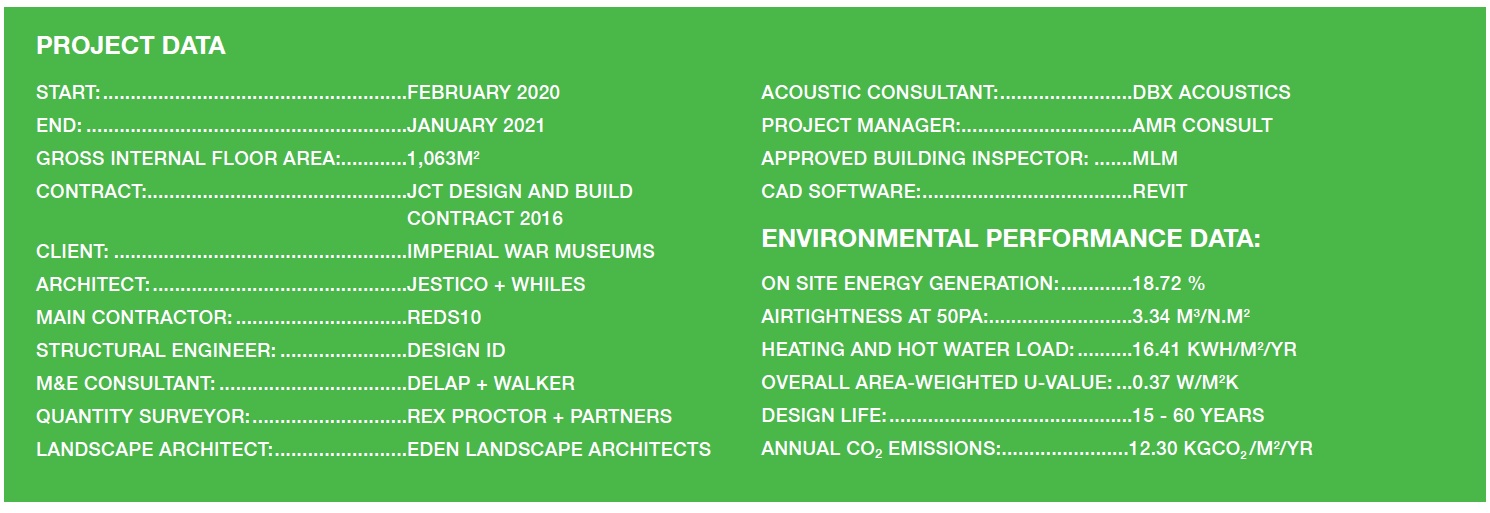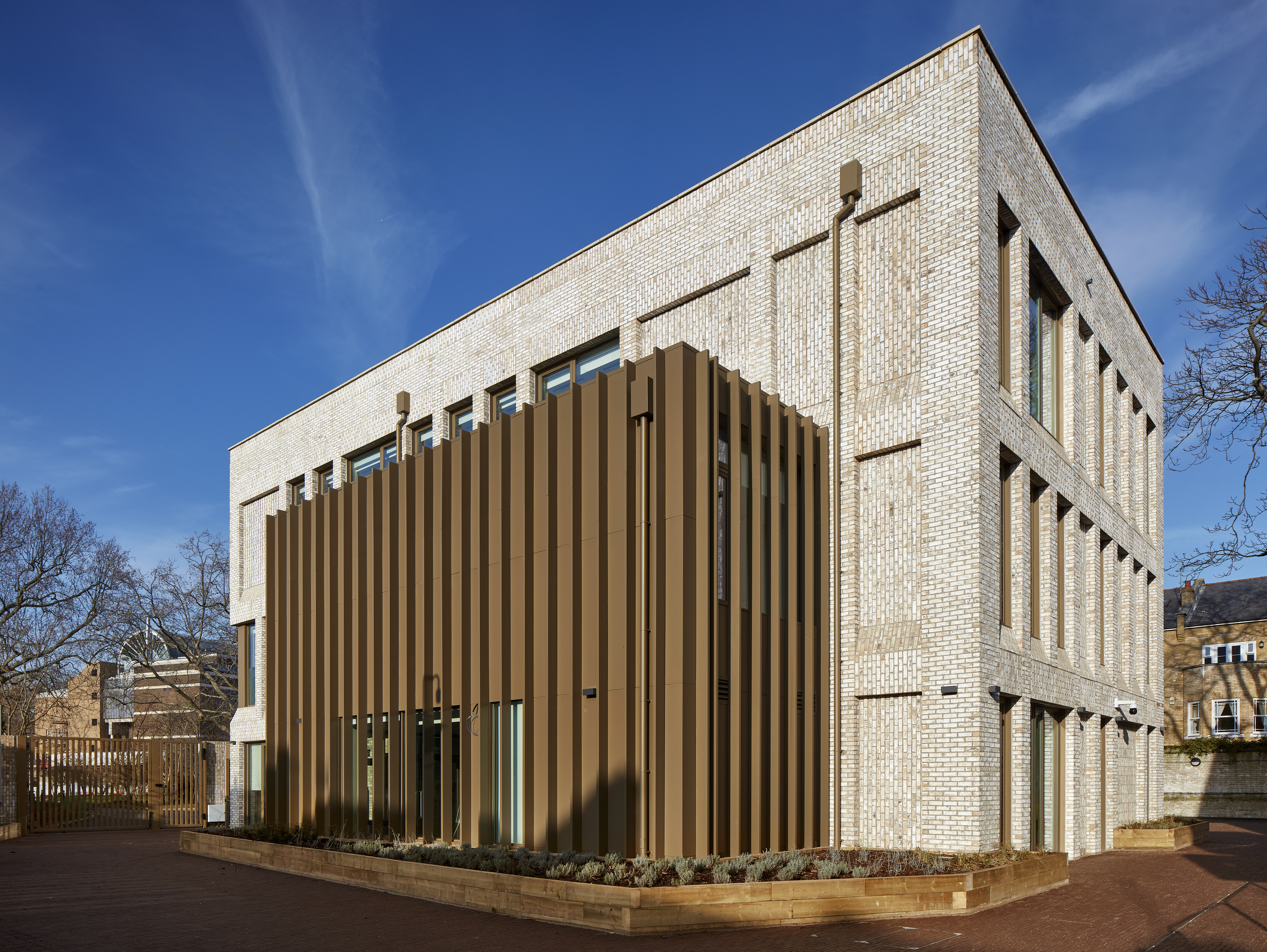The Imperial War Museum’s (IWM) new office headquarters, known as Parkside, combines cutting edge offsite construction and the latest in architectural design to deliver a high-performance building with traditional touches that respect its local surroundings. The building provides a new hub for the IWM to continue its mission to improve public understanding of war and conflict through its exhibitions, events, and programming. A JCT Design and Build Contract was the form of choice.
Parkside is a three-storey modular block that provides office space for the IWM in Lambeth, South London. Overlooking the Geraldine Mary Harmsworth Park, the building sits on a site behind the IWM’s existing Grade II-listed All Saints Annexe building. The new building is the principal headquarters for IWM staff – a central hub for employees situated close to the main museum in South London, and to relocate staff working at the current Annexe building, which is due to be repurposed for lease office space. In total, Parkside provides flexible workspace for over 180 staff.
The tight project timescale and limited sight space meant that offsite construction was considered from the start. Offsite specialist contractor Reds10 were engaged to work with architect, Jestico + Whiles. The aim for project team, beyond using offsite construction as a workaround for the site and timescale restraints, was to achieve the highest possible standards in architectural design and modular construction. The outcome was to deliver a functional and sustainable building that maximised stakeholder and community engagement. Throughout the design and development stages, the project team worked extensively with IWM’s teams to understand how the building’s workspaces should be used, whilst developing a scheme to address feedback from neighbours.
Externally, the building’s design blends with the Georgian townhouse vernacular of the surrounding local area in such a way that the use of modular construction is hard to recognise. The modular structure is disguised by a façade of light grey brick constructed in a more traditional way, arranged in a rectangular grid of recessed bays. The historic boundary wall to the park was also reconstructed to contain deep notches which form windows to the ground floor, and the main entrance gate from the park. The outermost masonry planes are coursed vertically to reinforce the openings and the recesses are highlighted with angled brick cills and corduroy panels. The vertical double-height windows, a further echo of the surrounding Georgian style, are framed in dark bronze and, along with the cladding, contrast with the masonry and provide a visual link back to the All Saints building.
The external design and construction were not just set up with the aim of blending in with the surroundings. Their integration has been configured at each stage to balance the works onsite and the works in the Reds10 factory – including the brick façade, multi-angle splays and double height windows. Techniques including 3D laser scanning of the building’s units, creating multiple building prototypes, and careful selection of materials, ensured that the quality level could be achieved whilst minimising risk and meeting the tight tolerances.
The purpose of Parkside is to provide a creative hub for innovative thinking and collaboration between the museum’s teams. The building also supports a commitment to develop smarter working practices. The building’s interior space has been designed to maximise the potential of these working practices. Simply arranged over three floors, the ground-floor houses the shared facilities, including a café, breakout spaces, and welfare facilities. The two upper floors provide a combination of open workspace and formal and informal meeting areas. Both the first and second floors are able to have the layout of the shared spaces fully reconfigured, with the use of raised access floors. This enables the building to have a level of flexibility to meet a variety of uses and long-term needs.
By using the modular construction, the building’s floor plates are able to be completely column-free, providing 14m clean spans of space. This is achieved despite having to support 100 tonnes of material, including a brown roof and photovoltaic panel array. The double height windows spanning multiple modules enable the internal spaces to benefit from floods of natural light and views across Geraldine Mary Harmsworth Park.
Sustainability was a key driver in establishing the building’s performance criteria, and in turn its offsite design and construction approach. The project is due to achieve BREEAM ‘Excellent’ rating, due to a number of features, including the use of triple aspect workspaces using natural ventilation and daylight strategies to minimise demand on active systems, a roof fitted with solar energy panels, a cycle store for 70 bicycles and an electric car charging port to promote sustainable modes of transport, the use of whole-life carbon and embedded carbon construction impact assessments, and the deployment of SMART building technology to help reduce overall energy use and drive 100% space productivity.
The success of Parkside owes much to the collaborative nature of the project and how this approach has been integrated through the project team and its stakeholders. It has enabled the development of a building that combines the very best of architectural design with modern methods of construction. The project team were connected digitally through Red10’s common data environment, ‘Autodesk Construction Cloud’. This provided a single input point for all parties – client, architect, factory, site staff. The system was able to generate virtual-reality walkthroughs in real time, which meant the parties could collaborate throughout the project lifecycle. Beyond the collaboration within the project team, Reds10 also achieved a Considerate Constructors ‘exceptional’ score in relation to community engagement. Putting industry best practice at the forefront of the project, they hosted several local apprentices and invested in projects to benefit the local community.
By embedding offsite construction within the architecture and design, this project has pushed the level of quality that can be achieved. With close collaboration, this has resulted in the creation of an impressive and functional space that still benefits from being sustainable and flexible. The use of the JCT Design and Build Contract helps to underpin and support that complexity – where offsite design meets traditional building onsite, and where extensive collaboration across the project team is desired. Where technological credentials in buildings are often displayed ostentatiously in the design, a building that is also sensitive to its historic surroundings, such as Parkside, really does point a way for the future of construction.

Image: Matt Clayton

